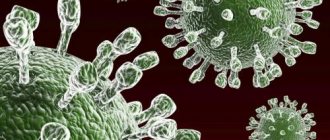Phimosis
(from Greek - tightening, compression) - narrowing of the foreskin, preventing the removal of the head of the penis.
In a newborn boy, the skin of the foreskin is usually fused to the head of the penis through epithelial adhesions (synechiae), which prevent or completely eliminate the free removal of the head. This temporary anatomical structure is called physiological phimosis and is the norm for young boys. Gradually, as the penis grows, the glans spreads the foreskin, a slow separation of the synechiae occurs and the glans opens. This process can continue until the beginning of puberty (puberty) of the boy’s development and does not require treatment. It happens that in little boys a small yellowish tumor-like formation is visible through the thin skin of the foreskin. This is smegma
- a mass of curdled consistency, consisting of desquamated epidermis of the skin and secretions of the sebaceous glands.
The fusion of the head with the foreskin closes the preputial space, which reduces the likelihood of infection and the development of inflammation. Sometimes smegma, which is produced in boys from a very early age, can accumulate in the preputial space, limited by synechiae, in the form of a tumor-like, dense formation, which frightens parents. Smegma rarely becomes infected
and, gradually softening, is independently evacuated from the space of the foreskin.
In case of a large accumulation of smegma,
minimal medical assistance is possible. In this case, a thin special probe is used to separate the synechiae, which prevents the discharge of secretions.
For newborn boys, the head is completely covered by the foreskin. Only 10% of children have the glans penis fully or partially open in the first year of life.
Sometimes parents notice that the child’s foreskin swells during urination, which most often, if there are no pathological changes in the foreskin, fits into the concept of the norm and does not harm the child. The foreskin swells due to inappropriate urine flow at the foreskin opening, but this usually does not result in residual urine in the bladder or the development of hydronephrosis. However, in this case, the boy should be consulted by a specialist.
Immediately after the birth of a child (preferably in the first week of life), he should be examined by a doctor who deals with issues of the male reproductive system - an andrologist. In the future, it is necessary to undergo regular medical examinations, especially during the onset of puberty. If it is impossible to see an andrologist, the boy should be examined by a urologist (or pediatric surgeon). At this stage of life, proper hygiene care is limited to daily bathing of the child and washing after defecation. It is better to use baby soap or special baby shampoos for this. Daily use of bactericidal (germ-killing) detergents is contraindicated. In this case, the normal microbiological environment inherent to humans is disrupted, which is replaced by pathogenic (disease-causing) microorganisms. In the future, as the child grows, during bathing the skin of the penis may gradually shift and the glans may be exposed. The procedure should be performed very carefully, without causing the slightest pain to the child. Immediately after toileting the head, the foreskin should be returned to its place to avoid the development of paraphimosis. It should be remembered that the area of the head of the penis contains a large number of pain receptors, and rough manipulations on the penis can lead a little boy to mental trauma and cause long-term fear of the man in the white coat.
Mothers of tiny men sometimes notice with horror that a whitish discharge with a specific odor has appeared on the head of the penis. This mixture of sebaceous gland secretion, moisture and dead epithelial cells accumulates in the pouch of the foreskin. The formation of smegma in boys is an absolutely natural and natural process that is observed in all mammals. To further reassure moms, smegma is translated as “sebum.” A small amount of smegma in a child is the norm, but there are exceptions.
Smegmalitis, phimosis and other troubles of little men
If the accumulation of smegma in a child between the leaves of the foreskin exceeds the norm, then pathogenic microorganisms can multiply in it. The foreskin becomes inflamed and the head turns red. So the accumulation of smegma in boys turns into smegmalitis. If the child also experiences phimosis, the situation requires the urgent intervention of a doctor who will tell you how to remove the smegma and relieve the baby of discomfort.
To understand the essence of the problem, the mother needs to know that before the baby was born, the head and foreskin developed as a single welded tissue. Only after the boy is born do they begin to gradually separate. The cells that die during separation are the same infant smegma that brings mothers to a pre-infarction state. It is gradually removed through the hole naturally. It is worth noting that infant smegma has nothing in common with adult smegma. It may take ten years for the tissue to completely separate. It is important to realize that this is normal and does not require intervention, much less treatment.
It is not the smegma itself that should alarm parents, but other symptoms, which include swelling of the skin on the penis when urinating, swelling of the foreskin or its redness. In this case, stagnation of smegma is a breeding ground for infection and must be eliminated.
Treatment and prevention
If the symptoms described above occur, you should not attempt to open the head on your own. Such treatment of stagnation of smegma in boys can lead not only to severe pain, but also to bleeding with subsequent fusion of the flesh. The surgeon will perform this manipulation safely, quickly and efficiently. A baby may not feel this at all, but older children quickly forget about the pain. After this procedure, the mother will need to rinse the child’s penis for several more days after each urination.
Another method is circumcision of the foreskin (circumization). Doctors have long come to the conclusion that this is a very beneficial procedure for men’s health, but in the modern world, circumcision is more likely associated with national customs and the culture of the family in which the child is growing up.
To avoid problems with the intimate areas of a newborn boy, you should take care of his hygiene from the first day. No special products are required - ordinary water and baby soap are enough. If we sum up all of the above in three words, then “leave the baby alone.” Forget about perfumes, antiseptics and rinsing the head under a strong stream of water. In the future, taking care of a boy's penis will become a habit along with brushing his teeth and washing his hands.
Often, troubles from smegma accumulated under the flesh arise in adolescence when the rules of intimate hygiene are neglected. It is this reason that leads to the appearance of infections that affect the genital organs. If you follow all the recommendations and rules, then smegma does not pose a danger to the health of boys.
Smegma in boys and men is a common phenomenon that can be called a physiological norm. However, excessive accumulation of “sebum” is a cause of concern in the adult population. Sometimes these fears are justified, because a change in the amount of discharge rarely happens just like that.
In any case, if you realize that “I have a strange white coating on my penis” and feel discomfort, in most cases a doctor’s consultation is required. If nothing bothers you, there is no reason to worry.
How to remove smegma for men and boys?
If the penis is not cleaned regularly, smegma can increase in volume, cause an unpleasant odor, infection and restriction of the movement of the foreskin.
To combat smegma in babies and young boys, you can use the following tips.
- Do not retract the foreskin of an infant or young boy. Parents should regularly contact their pediatrician to determine the age at which the foreskin can be retracted.
- Clean your genitals with water and mild soap. Carry out this procedure every time you wash your baby.
- Do not use tuffs, irrigations or antiseptics to clean the area of the penis under the foreskin.
Tattoo during pregnancy. What do you need to know?
As mentioned above, if the foreskin is pulled back too early, it can cause pain, bleeding and tears in the skin.
Therefore, it is important to leave the foreskin alone until the boy reaches the right age.
Boys and men who are able to retract their foreskin can follow these tips to clear the smegma from the penis.
- Gently push the foreskin back.
- Clean the area of the glans penis that lies under the foreskin with mild soap and rinse with warm water.
- Dry the cleaned area with a soft towel.
- Return the foreskin to its place, never leave it retracted.
Be sure to talk to your pediatrician or doctor if you have difficulty retracting your boy's foreskin. When retracting the foreskin, never use excessive force.
Treatment methods for balanoposthitis in children
Antibiotics have to be used only when the disease is caused by staphylococci or streptococci. If the disease is fungal in nature, penicillin antibiotics are contraindicated. The use of cephalosporin antibiotics will be required. There are also surgical methods of treatment, but they have to be resorted to very rarely.
Local treatment methods
- Baths. For baths, disinfectant and anti-inflammatory solutions are used: chamomile decoction or a solution of Furacilin, Chlorhexidine, Potassium Permanganate. Instead of Chamomile, you can use Sage or Plantain. To prepare a Chamomile decoction, you need to take 2 tablespoons of the mixture and pour a glass of boiling water over them, then put the decoction in a water bath and heat for 15 minutes. Cool the broth before use. To prepare a solution of Furacilin, take 2 tablets per glass of warm water. It is necessary to lower the head of the penis into the prepared solution for 10 minutes, after opening it as far as possible. You need to wash the inflamed area 5-6 times a day.
- Ointments. If baths do not help, then ointments are prescribed. When treating balanoposthitis in children, the following ointments are used - Levomekol, Miramistin, Locacorten, Baneocin. Before using the ointment, wash your child's genitals. You can make a bath with one of the disinfecting solutions. Then you need to put ointment under the foreskin. If it is impossible to open the head, then the ointment should be applied to a bandage and a bandage should be made. The doctor will tell you which ointment to use based on the symptoms and diagnostic results.
Chamomile decoction baths
Use of internal medicines
If the use of baths and ointments does not lead to an improvement in the condition, or the disease is complex, medications are used. Antibacterial and antifungal therapy may be required:
- Balanoposthitis is treated with cephalosporin antibiotics. The drugs Cephalosin, Cefixin, Ceftriaxone are used. These drugs can act on a wide range of bacteria. If the disease is caused by a fungal infection, the antifungal drug Fluconazole is prescribed. The antimicrobial drug Furagin is also used.
- For pain, non-steroidal anti-inflammatory drugs are prescribed - Ibuprofen.
- For balanoposthitis of allergic origin, antihistamines are used.
- Antipyretics, vitamins and drugs to strengthen the immune system are used as symptomatic therapy.
- If balanoposthitis is caused by endocrine diseases and obesity, then treatment of the underlying disease and diet are necessary.
Surgical methods of treatment
Sometimes with balanoposthitis it is necessary to perform a simple operation - circumcision of the foreskin. This surgical intervention completely eliminates complications and relapses of the disease. However, the operation is performed in very rare cases. Conservative treatment methods are usually sufficient. Surgery is required only when balanoposthitis is complicated by narrowing of the foreskin - phimosis. Surgical intervention may also be required in cases of protracted chronic form of the disease, when drug therapy does not help. Usually operations are easy and without consequences. To carry out such an intervention, you do not need to go to the hospital; it is carried out on an outpatient basis. The operation is not performed in case of severe inflammation, when the disease is acute. Circumcision prevents the risk of complications.
Smegma in babies
In the case when a large amount of white oily secretion accumulates between the foreskin and the head of the penis, then there is a possibility of developing inflammation - smegmalitis. If the inflammatory process develops against the background of phimosis, then the woman should definitely show the child to the doctor. Only a doctor can save the baby from the problem.
foreskin
Parents should be alarmed not by the oily secretion itself, but by the symptoms accompanying its appearance: swelling, swelling of the skin around the head when urinating, redness of the foreskin. They indicate the development of diseases.
Stagnation
When smegma stagnates, dense accumulations are formed, which can calcify and harden. The result is white plaques called smegmolites. When an infection occurs, the color of the smegma changes, more often to yellow or green, and the smell becomes unpleasant and pungent.
Excessive accumulation of smegma occurs when:
- lack of personal hygiene;
- narrowing of the foreskin (phimosis);
- diseases that are sexually transmitted if specific balanoposthitis (or balanitis) develops.
Whether proper care of your body is enough or whether you need to consult a doctor depends on your specific situation.
How to get rid of smegma? Smegma in boys is a common problem
This concept literally translates as sebum. Smegma consists of keratinized epithelium, moisture, fat and non-pathogenic microflora.
Externally, the secretion is a specific white discharge that appears on the head of the penis and collects under the skin.
The secretion of smegma occurs from birth, and during the period of growing up its production only intensifies. The secretion serves as a lubricant and ensures painless movement of the head.
If the synthesis of smegma increases beyond normal, it accumulates under the foreskin and becomes an ideal environment for the proliferation of pathogenic bacteria. They provoke an inflammatory process called smegmolitis. Excess secretion also threatens the appearance of small growths on the head at first - this pathology is called papillomatosis.
If the outflow of secretions is disrupted, characteristic redness and swelling appear in the area of the foreskin, and an unpleasant odor occurs.
This already speaks of phimosis, an equally dangerous disorder in boys and men. It is easy to avoid all these phenomena by knowing how the natural physiological process normally occurs and adhering to the usual rules.
Smegma normally looks like a white, thick liquid; a baby may have so little of it that it is invisible to parents. The main purpose of the secretion: unhindered and painless sliding of the head.
But if the outflow of smegma is disrupted or there is an excess of it, the baby may get sexual problems in the future.
The skin that covers the inside of the preputial sac contains glands. They produce a secretion, which, when mixed with dead cells, forms smegma. The accumulation of male lubricant is an ideal environment for the proliferation of pathogenic microorganisms. Boys have a high risk of serious illnesses, including cancer.
These experiences are confirmed if bacteria multiply in the accumulated secretion, and other symptoms of pathology occur.
As a result of the accumulation of smegma, a child may develop inflammation - smegmolitis or another dangerous disorder, phimosis, which is very difficult to treat.
Symptoms, signs and types
What does synechiae of the foreskin look like in boys? The presence of synechiae on the boy’s penis can be seen visually (see photo). Adhesions form a characteristic fold of skin with a compacted structure.
If synechiae are the result of progression of the inflammatory process, then identifying the pathology yourself will also not be difficult.
Signs of pathogenic synechiae are the following symptoms:
- pain when urinating;
- itching and burning in the area of the head of the penis;
- swelling of the skin in the area of adhesions;
- attacks of pain when trying to expose the head of the penis;
- the presence of discharge resembling pus;
- baby crying when urinating;
- redness of the head of the penis.
Synechiae can be physiological and traumatic. In the first case, adhesions will not cause discomfort to the boy. Traumatic synechiae are always formed under the influence of injuries, and their presence is accompanied by pain of varying intensity.
In this case, the provoking factor is the entry of pathogenic bacteria into the baby’s genitourinary system (through the external environment, as a result of the progression of certain diseases, or through the mother’s body during pregnancy).
Types of synechiae in boys:
- complete fusion;
- incomplete fusion (pictured above).
Balanoposthitis in boys often develops acutely. Usually, after going to the toilet, the child begins to complain of burning and itching in the area of the glans penis, pain or difficulty urinating. Small children become restless and cry when urinating. Examination reveals redness and swelling of the head of the penis and foreskin;
when the head is exposed under the foreskin, accumulated smegma is discovered, which has an unpleasant odor.
With balanoposthitis in boys, there may be abundant cheesy or serous-purulent discharge from the preputial sac. A rash, cracks or diaper rash may appear on the skin and mucous membranes of the genital organs.
With further progression of balanoposthitis in boys, erosions and peeling of the skin may appear.
In addition to local signs, with balanoposthitis in boys, general symptoms are expressed: malaise, lack of appetite, poor sleep, irritability. Often in children, the body temperature rises to 37-38°C, and the inguinal lymph nodes become enlarged. Due to the fact that the child tries to hold back urination due to its pain, daytime and nighttime enuresis may develop.
Megma in women
Secretions from the sebaceous glands are also common in women. In the absence of proper hygiene of the genital organs, smegma tends to accumulate in the area of the clitoris and labia minora. Despite the fact that the appearance of this secretion is normal and natural, its specific smell becomes a powerful impetus for procedures that help get rid of secretions.
The characteristics of that part of the female genital organs that are located outside affect the accumulation of various types of secretions on the surface. The anus is located quite close, which can also contribute to contamination. The glands located near the clitoris produce smegma, which tends to accumulate and subsequently decompose.
We invite you to read Accurate diagnosis of HIV is very important, but what if the test is false
At the entrance to the vagina there are also glands that are responsible for the production of mucus. As a result, in the absence of proper hygiene, all these secretions create comfortable conditions for the life of harmful microorganisms, as well as their multiplication. The next stage is the occurrence of inflammation and purulent processes.
Also, the resulting infection can spread further, which is usually facilitated by sexual contact. Inflammation can manifest itself in the vagina and uterus. The presence of moisture in the area of the labia and various types of secretions cause the appearance of warts with a sharp surface. Therefore, genital hygiene is a very important element of water procedures.
It is imperative to wash yourself after bowel movements and during menstrual flow. For water procedures, soap and water at a pleasant temperature are enough. With the onset of more independent adolescence, the mother needs to tell the girl about hygiene procedures and their importance. This ritual should be made an integral part of your life, just as in the case of brushing your teeth and similar procedures.
Treatment of smegma in women proceeds in the same way as in the male version. When secretions accumulate, you should pay more attention to water procedures. A daily change of underwear is also required. If there is an inflammatory process, you should contact a gynecologist, who will be able to accurately determine the current condition and prescribe appropriate treatment.
You should not be afraid of the presence of this secret. If smegma is not secreted in large quantities, there is no reason to worry. This is a completely normal physiological phenomenon that is characteristic of both adults and children. It is important to ensure that the amount of secretion does not increase and there is no inflammation. Also, in case of pain and burning sensations while visiting the toilet and at rest, it is advisable to see a specialist and consult about your condition.
Treatment options
Excessive fluid accumulation contributes to the formation of inflammatory processes and pain in the groin area. However, getting rid of excess grease is quite simple. Treatment consists of regular genital hygiene.
When the head is inflamed, special antiseptics are used to treat it. If their use is ineffective, antibiotics and ointments are used.
In sexually active men, any pain in the genital area, as well as accumulation of discharge, should be diagnosed and differentiated from candidiasis and other sexually transmitted diseases.
Treatment in children
In a child, an excess amount of smegma accumulates most often due to phimosis. Fluid collects under the narrowed flesh, which cannot be fully excreted along with urine.
This accumulation of secretion is a favorable substrate for the development of inflammatory infectious processes, therefore treatment in a child includes the following steps.
Elimination of phimosis or abnormal development of the head of the penis. To correct pathology, conservative methods are used (baths, steaming, etc.), but most often this is surgical treatment. Boys undergo an operation, the essence of which is to circumcise the foreskin.
- Sanitation of the organ head. To do this, use regular rinsing with antiseptics until the inflammation disappears.
- Regular proper hygiene of the genital organs in boys. It consists of teaching the child hygienic procedures in the form of daily washing with warm water and soap of the entire organ and the head in particular.
A small child may not notice the appearance of such a lubricant, however, parents should carefully monitor his health and the normal condition of all organs.
The presence of smegma not only in men, but also in children is normal. A person should be alerted by the fact that the amount of secretion has increased sharply, pain or burning has appeared in the groin area at rest or when urinating.
This is a reason to consult a doctor to rule out sexually transmitted diseases, especially if there is a change in color or an unpleasant odor.
It is important not to delay visiting the hospital to avoid complications. It is required to carry out regular preventive maintenance and monitor the condition, cleanliness and health of the genitals
Author of the article Simakov Oleg
A practicing journalist, he tests recipes on himself. Knows everything about men and traditional medicine.
Substance Elimination
Doctors recommend regularly washing off smegma in children under running water. This way, the risk of problems arising as you grow older is reduced to zero. To do this, you can limit yourself to baby soap, which has a gentle effect on the organ, but produces a disinfectant effect. When maintaining children's hygiene, you need to use diapers and wipes without adding alcohol. You can use special powders to eliminate moisture.
There is no point in trying to open the foreskin or increase its mobility. Doing so will cause pain, possible bleeding and damage to the skin. If you have phimosis or smegmolitis on the head of the penis, you should not self-medicate, but immediately consult a doctor.
Smegma is treated as follows:
- Treatment of pathological development of the head. Sometimes steaming and baths are enough, but in most cases the foreskin must be removed. Circumcision is performed surgically. After the operation, for some time it is necessary to wash the child’s genitals after each urination.
- Use of medicinal solutions. If the inflammatory process has begun, ordinary rinsing is not enough. The doctor prescribes daily use of antiseptic solutions until complete recovery. Often, 10 ml of Levomekol ointment is injected into the opening of the foreskin with a syringe without a needle, washing the problem area. This way you can wash away everything that has accumulated on the head and under the foreskin. At night, apply a compress from the same ointment. If necessary, add 2-3 drops of pure sea buckthorn, olive oil, Vaseline or oil vitamin solutions. Baths with Furacilin or Ectericide may be prescribed.
It is very important from childhood to instill in growing men the observance of the rules of hygiene of the reproductive system. Very often, an exacerbation of the problem is observed in adolescents during puberty, when the rules of caring for the penis are neglected.
Adult men who experience heavy discharge often ask how to remove smegma. Unlike children, treatment will be carried out differently.
First, the man is prescribed rinses with antiseptic solutions. If the inflammation does not go away, antibiotic treatment is used. They can be available in the form of tablets or ointments. The prescription is carried out by the attending physician, since self-medication can lead to complications and decreased reproductive function.
Before prescribing a course of treatment, the doctor establishes an accurate diagnosis of the disease. This is done in order to exclude the possibility of a sexually transmitted infection. Men with an active sex life should be attentive to any changes in their well-being.
The only way is surgery? Wait, and do not act with radical methods. It is POSSIBLE to increase potency! Follow the link and find out how experts recommend treating...
Most boys and men are faced with the phenomenon of a whitish coating on the head of the penis, sometimes accompanied by a pungent and unpleasant odor. Should I worry about this, what is the reason for its appearance and when can smegma actually lead to unpleasant consequences?
According to the interpretation of the term from Greek, smegma is nothing more than “sebum”. Under the foreskin, the secretion of the sebaceous glands (preputial glands), moisture, and dead epithelial cells accumulate. In the absence of daily hygiene procedures, a whitish coating in men who have not undergone circumcision accumulates in the prepuce sac and can cause inflammatory processes.
Composition of the discharge:
- Fats.
- Specific non-pathogenic microflora (it includes mycobacteria smegma, which have the ability to assimilate fats).
- Ferromones.
- Bactericidal substances.
The reason for the greatest accumulation of smegma is the period of maximum sexual activity in men (16–25 years), and as they grow older, the production of “sebum” decreases. In old age, smegma is practically not released, but this is not a reason to skip hygiene procedures.
What happens when whitish plaque remains in the preputial sacs for a long time? Stagnation is especially dangerous with phimosis, as well as if you ignore the need for daily showering. If smegma is not removed, this can cause the development of balanitis, balanoposthitis, and with a systematic lack of genital hygiene, there is a high risk of developing precancerous pathologies (penile papilloma, etc.) or penile cancer. In addition, “old” smegma has a very unpleasant and pungent odor, which is felt by others, and turns from whitish to yellowish-greenish.
However, the presence of smegma in uncircumcised men is necessary; it is a natural lubricant that allows the prepuce to slide easily along the head of the penis.
Reasons for appearance
An accumulation of smegma in a child (a photo of the pathological process clearly shows the problem) appears with the following predisposing factors:
- poor-quality and irregular genital hygiene;
- narrowing of the prepuce against the background of the development of phimosis.
If alarming symptoms appear, parents should pay due attention to hygiene, and only if these measures do not bring any improvement, consult a doctor. Frequent and abundant accumulation of smegma provokes the formation of pathogenic microflora, which favors the proliferation of pathogens
This leads to inflammation and the appearance of tumors
Frequent and abundant accumulation of smegma provokes the formation of pathogenic microflora, which favors the proliferation of pathogens. This leads to inflammation and the appearance of tumors.
Phimosis is a physiologically normal condition that is inherent in newborn children. In 5% of cases, the foreskin is mobile, so the head of the penis can be easily exposed and washed thoroughly with water, eliminating the possibility of smegmalitis.
Literally translated, phimosis means tightening or compression. With phimosis, the head is tightly closed, and opening it can be quite painful for boys. A similar condition can occur in children up to the age of seven, and this is by no means considered a pathology.
But if this does not go away after reaching 7 years of age, the foreskin remains narrowed, in which case parents should sound the alarm and contact specialists.
Any manifestation of phimosis in boys after 7 years of age is a pathology; the problem can lead to serious complications.
So, if phimosis is a physiologically normal condition, then why does smegma give off an unpleasant odor?
The reasons for this phenomenon are as follows:
- diagnosis of diabetes mellitus;
- hormonal imbalance;
- diseases that contribute to excessive secretion of the gonads.
Sometimes the smell of smegma becomes repulsive and intense, and when it appears, it is worth undergoing an examination to find out the cause. Such a symptom always means the presence of some pathological disorders of the genitourinary system. The most common diseases in childhood are balanitis and balanoposthitis, which are a consequence of physiological phimosis.
Causes, symptoms and treatment of pathologies
Inflammation of the penis occurs acutely or has a chronic course, but the first form of the disease is more common. To make a diagnosis, a specialist just needs to interview the parents and examine the baby. In case of a stable pathological process, urine and blood tests are necessary. The chronic form of the disease is more difficult to treat; the inflammatory process subsides from time to time, but poorly healing cracks and scars may remain on the penis.
Postitis (inflammation of the foreskin)
Posthitis occurs in children for several reasons:
- skin irritation due to accumulated smegma or urine;
- penetration of bacteria due to the baby’s habit of fiddling with the genitals;
- allergic reaction;
- kidney diseases;
- diabetes.
The process of inflammation of the foreskin is accompanied by swelling of the surrounding tissues - parents notice that the baby’s penis is swollen. Other symptoms are also present:
- increase in temperature;
- pain;
- redness of the affected skin;
- enlarged inguinal lymph nodes;
- sometimes – difficulty urinating;
- with advanced pathology, drops of pus protrude from under the foreskin.
When parents discover the development of the inflammatory process, they must carry out a number of procedures:
- Make a bath with a pale pink solution of potassium permanganate, a Furacilin tablet or a few drops of Sangviritrin. Antiseptics will destroy pathogenic flora and wash away particles of accumulated organic substances.
- Use Streptomycin or Levomekol to lubricate the reddened area of the skin.
If there is a tendency to reduce inflammation, the above procedures should be followed until recovery. To reduce discomfort, you can use decoctions of chamomile and oak bark.
Balanitis (inflammation of the head)
Balanitis is quite common in infants, but can also appear at an older age. The glans penis becomes inflamed due to accompanying factors:
- poor hygiene;
- incorrectly selected diaper size or tight underwear;
- rare diaper changes;
- aggressive substances used in washing clothes;
- frequent use of soap;
- avitaminosis;
- hypothermia;
- fungal infection;
- endocrine disorders.
The incubation period of the disease lasts up to three days, after which symptoms begin to appear.
Mothers rarely pay attention to the fact that the head of the reproductive organ turns slightly red, but then a small rash forms on the tip, merging into spots over time. Further signs become more pronounced:
- edema;
- pain;
- the head acquires a burgundy-red, sometimes bluish tint;
- discharge of purulent exudate;
- itching (sometimes the child scratches the area around the genitals);
- problems with urination;
- fever or fever;
- When an illness occurs due to a yeast infection, a white coating is visible on the penis.
Balanitis at the initial stage of development does not require complex treatment. Therapy includes:
- washing the genitals with soapy water;
- baths with Furacilin (1 tablet per 200 ml of liquid), Miramistin or potassium permanganate;
- use of ointments (Levomekol, Sintomycin);
- ozone therapy, electrophoresis.
The procedures are performed 2–3 times a day for 5 days. At an advanced stage, antibiotics and even surgery may be needed. During the operation, the foreskin is cut, and sometimes circumcision is performed (we recommend reading: how is circumcision of the foreskin performed in children?).
Balanoposthitis (inflammation of the head and foreskin)
Balanoposthitis develops due to the following reasons:
- lack of hygiene;
- deposition of urine salts in skin folds;
- the formation of constrictions between the head and foreskin;
- rubbing the skin with linen;
- endocrine diseases;
- hypothermia.
There are several forms of the disease:
- acute – develops spontaneously without any accompanying pathologies;
- gangrenous - during the inflammatory process of the preputial sac, the head is pinched by the adjacent tissue, blood flow is disrupted;
- purulent - develops when the urethral opening is partially blocked, accompanied by the release of pus;
- erosive - when the epithelium is destroyed, cracks appear, forming scars after healing.
Prevention of balanoposthitis
It is important to detect balanoposthitis in time, taking into account the causes and main signs of the disease. Seeking help and starting treatment on time will yield results; complications are rare. Balanoposthitis can be prevented. There are some recommendations for this:
- strictly observe the boy’s hygiene rules;
- exclude unnecessary touching of the child’s genitals, so as not to injure or cause infection;
- Wash your genitals daily and after bowel movements without soap;
- change diapers for babies in a timely manner, while providing air baths;
- select diapers and panties made of soft fabric and without rough seams according to age;
- do not push back the foreskin of the penis.
In order to prevent the disease, it is necessary to develop in the boy the habit of daily care of the genitals. At an older age, children should be taught to use the shower and remove excess smegma on their own, and change their underwear daily.
Balanitis is a fairly common disease, which is an inflammation of the head of the male genital organ. Most often it affects boys under 5 years of age. The disease can affect only this part of the penis or the inner side of the foreskin, which is defined as posthitis. If suppuration simultaneously affects both of these areas, then balanoposthitis is diagnosed.
The disease can negatively affect the sexual activity of a mature man and his ability to fertilize. A spermogram will help you obtain all the information to identify infertility and eliminate causes of concern.
We invite you to familiarize yourself with the Diagnosis of syphilis: accurate tests and characteristic symptoms.
Causes of smegma accumulation
the formation of smegma in small volumes and easy excretion in the urine stream is considered normal and does not pose a threat to health. But sometimes, for various reasons, the amount of ligament can increase sharply, creating favorable conditions for the growth and reproduction of pathogenic microorganisms. Factors provoking this violation are considered:
- neglect to perform hygiene procedures in the intimate area;
- phimosis – narrowing of the external opening of the foreskin;
- genitourinary infections.
The entire secretion does not have time to be eliminated in full, so it accumulates in the preputial sac - the cavity of the foreskin, and acquires a sharp, repulsive aroma.
The accumulation of smegma, combining with salts, acquires a dense consistency. Such formations are called smegmolites. They gradually harden and settle in the preputial sac. But even without the presence of crystals, the substance, stagnating, loses its bactericidal properties and becomes the cause of the development of various infections in the body. The most common are:
- balanitis - inflammation of the head of the genital organ;
- postitis is a pathological process affecting the foreskin;
- Balanoposthitis is a combination of the two above diseases.
Attention! In rare cases, against the background of reduced immunity, oncological processes may develop that affect the tissues of the penis
What is smegma and what does its accumulation under the foreskin indicate?
Fresh smegma is white and is usually washed away with streams of urine. This substance is intended to moisturize the glans penis and facilitate the sliding of the foreskin. Therefore, excreting it in small quantities is normal. The main thing is to remove it in time using hygienic procedures.
But it happens that smegma is released in significant quantities, which is fraught with the proliferation of pathogenic microorganisms. It is necessary to understand that it is not the smegma itself that is dangerous, but its stagnation. As a result, the foreskin becomes inflamed and the head of the penis turns red (this phenomenon is called smegmolite). With phimosis (up to 7 years of age, physiological phimosis occurs), when the outflow of smegma is disrupted, the foreskin becomes swollen and red.
Smegma can easily be confused with pathological discharges, such as:
- A curd-like discharge that characterizes thrush. During the period of fungal infection of the mucous membrane of the penis, a cheesy substance accumulates under the foreskin. Additional symptoms include burning of the groin area and soreness. This is extremely rare in boys.
- Discharge of pus in diseases such as gonorrhea, chlamydia. This discharge is gray in color and has an unpleasant odor.
What to do
If smegma appears, you should consult a gynecologist and rule out bacterial and fungal infections. When itching, redness and swelling are noted along with a white coating, an infectious disease should be assumed. This pathology cannot be cured without antibiotics and antiseptics. If you simply remove the discharge, the disease will become chronic and it will become much more difficult to completely get rid of it.
It is important to start treatment if. This should be reported to the doctor, and he will make a presumptive diagnosis.
The smell of rotten fish, for example, most often accompanies chlamydial inflammation.
When there is no infection and you just need to remove the smegma, a cotton swab soaked in vegetable oil will help. It is better not to use soap, so as not to provoke irritation.
Smegma, who is at risk
A large accumulation can form due to the narrowness of the foreskin, so smegma is often diagnosed in a child, which is not a disorder. But many mothers make a big mistake by not controlling the process of producing this substance.
The fact is that even before birth, the foreskin and the head of the penis in boys are a single whole. Only after birth do these genital organs begin to separate from each other.
During this process, many epithelial cells die, mixing with smegma, and they appear outside in the form of a white liquid with an unpleasant odor, often resembling a cheesy discharge and causing real panic in young mothers. But there is no place for panic here. It should be remembered that this is a normal physiological process.
The very release of smegma out through the opening of the foreskin is the norm. You need to worry if signs of inflammatory processes appear. The foreskin swells and redness appears. This already indicates possible infection with an infectious disease. Daily hygiene procedures and bathing newborn boys in herbal decoctions eliminate this phenomenon.
But if you do not control and start this process, then it is likely that the baby will get sick. In the first days of life, it is simply impossible to clean the head of the penis without causing pain to the child. In addition to painful sensations, such actions can injure the foreskin. Therefore, this is a disease most often found in boys in the first months of life.
Physiological role of smegma
Smegma in men ensures normal function of the sexual organ. The fat-like substance performs important tasks:
- ensures sliding of the head of the phallus;
- prevents the appearance of mini-traumas or cracks when the head of the penis exits the prepuce;
- suppresses local infections (due to disinfecting components).
If there are no pathologies, smegma in men resembles a whitish coating on the head of the phallus or at its base. The smegma under the foreskin is usually homogeneous (although a cheesy consistency is also possible) and has a tart odor.
Treatment of excessive smegma accumulation
Often in children, smegma accumulates in excess quantities due to phimosis. A substance accumulates under the narrow foreskin and is not fully excreted in the urine. Getting rid of excess smegma is quite simple; it consists primarily of careful hygiene of the boy’s genitals. It is necessary to properly care for the genitals from early childhood; accordingly, parents should teach their child to do this so that in adult life he does not have problems with diseases from uncleanliness.
If the head of the penis is still inflamed, the boy’s parents can use baths with a weak solution of manganese or chamomile infusion. Douching with Miramistin is also a good antiseptic. Similar procedures are carried out until the alarming symptoms disappear completely.
Thus, you need to take care of your child and carefully monitor the condition, cleanliness and changes of his genitals.
Smegma in men
In adults,
the secretion of the glands of the penis has a typical appearance of an oily whitish substance or. It consists not only of the secretion of glands, but also of the epithelium of the penis.
Due to the fact that it is an excellent breeding ground for bacteria that feed on the fatty acids it contains, the unpleasant odor of this secretion is formed
.
With normal health and personal hygiene, smegma will not cause any discomfort. However, with pathological processes associated with its infection, pain, itching and swelling of the head of the penis often develop.
How to get rid of it
In accordance with the unpleasantness of the accumulating substance, both visually and taking into account its specific odor, a reasonable question arises - “how to get rid of smegma in men.” It is impossible to completely stop the production of this secret
, so the only thing that can help combat it is
careful adherence to intimate hygiene every day
.
And if abundant formations accumulate, how to get rid of them? The answer will be similar to the previous one, only taking into account the fact that, most likely, the frequency of visiting the bathroom will need to be increased.
In situations where smegma becomes inflamed, treatment is prescribed by a doctor.
, often in the form of the use of antiseptic solutions. If the situation is complex, then antibiotics in tablet form or local ones in the form of ointments can also be used.
Self-medication is under no circumstances allowed. Only a specialist will be able to determine what is happening in a man’s body and which drug is suitable for him.
Although the appearance of a white substance is disturbing and raises doubts about the health of a boy or man, in practice this substance does not pose any threat
.
And with careful attention to your body and maintaining personal hygiene, you can not only avoid the onset of the pathological process, but also reduce the unpleasant visual impression of the appearance of a whitish coating on your manhood.
Preventive actions
Is smegma so dangerous, and can there be troubles associated with its excessive secretion? In order not to carry out long-term treatment of complications caused by stagnation of smegma, it is important, starting from childhood, to regularly carry out hygiene procedures, and if phimosis is present, to eliminate it.
Like any natural body secretions, smegma, which serves as a lubricant for the head of the phallus, must be removed. Otherwise, when accumulated, it begins to act on delicate skin as an irritant, which causes inflammatory processes.
Usually, smegma causes more trouble for boys who have phimosis or adolescents who have not been taught the basics of hygiene or who completely ignore them. In youth, this is fraught with the development of infectious processes, especially during early sexual activity, and the occurrence of pathologies of the genitourinary organs. But with proper care of intimate organs from birth, smegma does not cause boys or men any trouble.
The very fact that smegma forms in an infant, a child, and in general throughout almost a man’s entire life should not bother him.
Because this substance is completely normal
and its release is a physiological process, then there should not be any inconvenience, with appropriate hygiene.
Young parents are often frightened by the first appearance of a specific secretion, and an adult man begins to worry when this secretion accumulates or is produced too actively, from which he notices the head literally completely covered with plaque. This not only does not look aesthetically pleasing, but is also perceived as a signal of a problem.
.
It is important to know that the pathological process will not be detected solely by the release of smegma
, but will be supplemented by other symptoms. And it is equally important to understand what this specific secret of the male body is and what smegma looks like in boys and men.
How does it look and form
itself is a specific substance secreted by glands
located on the foreskin. It contains fats, pheromones, bactericidal substances and non-pathogenic flora, represented by mycobacteria.
Smegma in boys is produced by these glands, especially during periods of frequent sexual activity, which most often occurs between the ages of 17-25, while in older people the secretion of this secretion is almost absent
.
As already mentioned, glands produce this substance; they are called prepuce and are located under the foreskin. They begin to function in infancy and there is relatively little secretion during this period. gradually increases with puberty
young man. Regulation of the activity of the glands occurs by the body itself and is gradually balanced.
Smegma is an oily substance, has a whitish tint and a specific odor.
.
You can see what smegma looks like (photos below).
The concept of norm
Smegma in men looks like an oily whitish coating on the foreskin and has a rather pungent odor. Sebaceous glands, sweat, and dead skin cells form the basis of this mixture. Their accumulation in the pouch of the foreskin is observed in all mammals.
The secretions consist of:
- male pheromones;
- sebum;
- specific microflora;
- bactericidal substances.
Such discharge is typical for all ages, starting from infancy. Normally, a little whitish substance accumulates on the head of the penis. Its abundant amount can be observed only during the period of greatest sexual activity; in all other cases it will indicate pathology.
Our regular reader got rid of PROSTATITIS using an effective method. He tested it on himself - the result was 100% - complete relief from prostatitis. This is a natural remedy based on honey. We tested the method and decided to recommend it to you. The result is fast. EFFECTIVE METHOD.
Teenagers and young adults are more likely to experience this than men over the age of 30. The senile period is indicated by the absence of such secretions at all. The presence of smegma improves the sliding of the foreskin along the head of the penis, being a natural lubricant for better opening of the penis.










